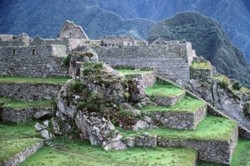|
Machu Picchu Machu Picchu is a well-preserved pre-Columbian
Inca ruin located on a high mountain ridge, at an elevation of about
2,350 m (7,710 ft). Machu Picchu is located above the Urubamba Valley in
Peru, about 70 km (44 mi) northwest of Cusco. Forgotten for centuries by
the outside world, although not by locals, it was brought back to
international attention by Yale archeologist Hiram Bingham who
rediscovered it in 1911, and wrote a best-selling work about it. Peru is
pursuing legal efforts to get back thousands of artifacts that Bingham
removed from the site. Machu Picchu is a well-preserved pre-Columbian
Inca ruin located on a high mountain ridge, at an elevation of about
2,350 m (7,710 ft). Machu Picchu is located above the Urubamba Valley in
Peru, about 70 km (44 mi) northwest of Cusco. Forgotten for centuries by
the outside world, although not by locals, it was brought back to
international attention by Yale archeologist Hiram Bingham who
rediscovered it in 1911, and wrote a best-selling work about it. Peru is
pursuing legal efforts to get back thousands of artifacts that Bingham
removed from the site.Machu Picchu is located 70 kilometers to the northwest of Cusco, on the crest of the mountain Machu Picchu, located about 2,350 meters above sea level. It is one of the most important archaeological centers in South America and as a consequence the most visited tourist attraction in Peru. From the top, at the cliff of Machu Picchu, one can appreciate the vertical precipice of 600 meters ending at the foot of the Urubamba River. The location of the city was a military secret because its deep precipices and mountains were an excellent natural defense. According to the archaeologists, Machu Picchu was divided in three great sectors: the Sacred District, the Popular District, to the south, and the District of the Priests and the Nobility (royalty zone). Located in the first zone are the primary archaeological treasures: the Intiwatana, the Temple of the Sun and the Room of the Three Windows. These were dedicated to Inti, their sun god and greatest deity. In the royalty area, a sector existed for the nobility: a group of houses located in rows over a slope; the residence of the Amautas (wise persons) was characterized by its redish walls, and the zone of the �ustas (princesses) had trapezoid-shaped rooms. Inside the citadel existed a sector assigned as the jail, where the prisoners were punished inside rock niches. The Monumental Mausoleum is a stone block with a vaulted interior and carved walls. It was used for rites or sacrifices. All of the construction in Machu Picchu uses the classic Inca architectural style of polished dry-stone walls of regular shape. The Incas were masters of this technique, called ashlar, in which blocks of stone are cut to fit together tightly without mortar. Many junctions are so perfect that not even a knife fits between the stones. The Incas never used the wheel in any practical manner. How they moved and placed enormous blocks of stones is a mystery, although the general belief is that they used hundreds of men to push the stones up inclined planes. The Incas did not leave any documentation about that process because they did not possess a written language. The space is composed of 140 constructions including temples, sanctuaries, parks and residences. There are more than one hundred flights of stone steps � often completely carved in a single block of granite � and a great number of water fountains, interconnected by channels and water-drainages perforated in the rock, designed for the original irrigation system. All visits to Machu Picchu at some point leave from Cusco, which can be reached via a domestic flight from Lima, or international flight from La Paz, in Bolivia. Taking the tourist train from Cusco (which takes 3.5 hours to get to Machu Picchu), you have several options. The most common way is to take the train to Machu Picchu in the morning, explore the ruins for a few hours and return to Cusco in the afternoon. The train terminates at Puente Ruinas station, where buses take tourists up the mountain to Machu Picchu. Strangely, Machu Pichu station is at Aguas Calientes (2km before Puente Ruinas station) but is not the station used by tourists on a day trip. Another option is to hike the Inca Trail, on either a four-day or two-day version, both of which are controlled by the government. They require you to be reasonably fit, and takes a few days, sleeping in tents. Another option is to stay overnight near the ruins themselves, rather than return on the same day. There are many hotels at nearby Aguas Calientes, or the more expensive Machu Picchu Sanctuary Lodge, the only hotel located at Machu Picchu itself. Buses run from Aguas Calientes to the ruins throughout the day, an 8km ride up the mountain. A helicopter service from Cusco to Aguas Calientes, via a 24 passenger Russian Mi-8 helicopter, is also available. Helicopter flights direct into Machu Picchu stopped in the 1970s due to concern about their damage to the ruins. Machu Picchu Pictures
|
|
||||||||||||||||||||||||||||||||||||||||||||||||||||||||||||||||||||||||||||||||||||||






